1973 CHEVROLET MONTE CARLO flat tire
[x] Cancel search: flat tirePage 5 of 86
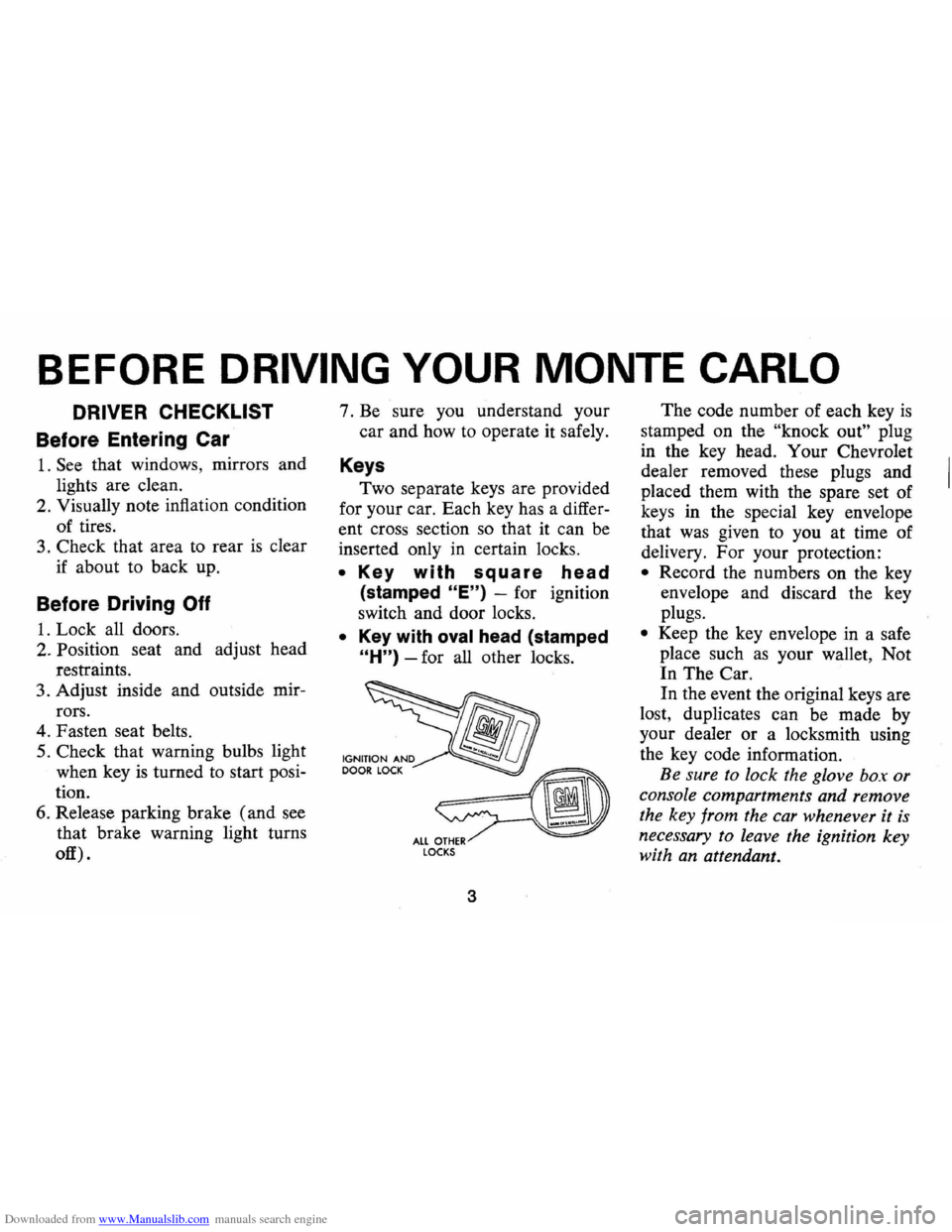
Downloaded from www.Manualslib.com manuals search engine BEFORE DRIVING YOUR MONTE CARLO
DRIVER CHECKLIST
Before Entering Car
1. See that windows , mirrors and
lights are clean.
2 . Visually note inflation condition
of tires.
3. Check that area to rear is clear
if about to back up.
Before Driving Off
1. Lock all doors.
2. Position seat and adjust head
restraints.
3. Adjust inside and outside mir
rors.
4 . Fasten seat belts.
5. Check that warning bulbs light
when key
is turned to start posi
tion.
6 . Release parking brake (and see
that brake warning light turns
off). 7
. Be sure you understand your
car and how to operate it safely.
Keys
Two separate keys are provided
for your car. Each key has a differ
ent cross section so that it can be
inserted only
in certain locks.
• Key with square head
(stamped "E") -for ignition
switch and door locks.
• Key with oval head (stamped
"H") -for all other locks.
fib
~ ALL OTHER LOCKS
3
The code number of each key is
stamped on the "knock out" plug
in the key head. Your Chevrolet
dealer removed these plugs and
placed them with the spare set of
keys in the special key envelope
that was given to you at time of
delivery. For your protection:
• Record the numbers on the key
envelope and discard the key
plugs.
• Keep the key envelope in a safe
place such
as your wallet, Not
In The Car.
In the event the original keys are
lost, duplicates can be made by
your dealer or a locksmith using
the key code information.
Be sure to lock the glove box or
console compartments and remove
the key from the car whenever it
is
necessary to leave the ignition key
with an attendant.
Page 14 of 86
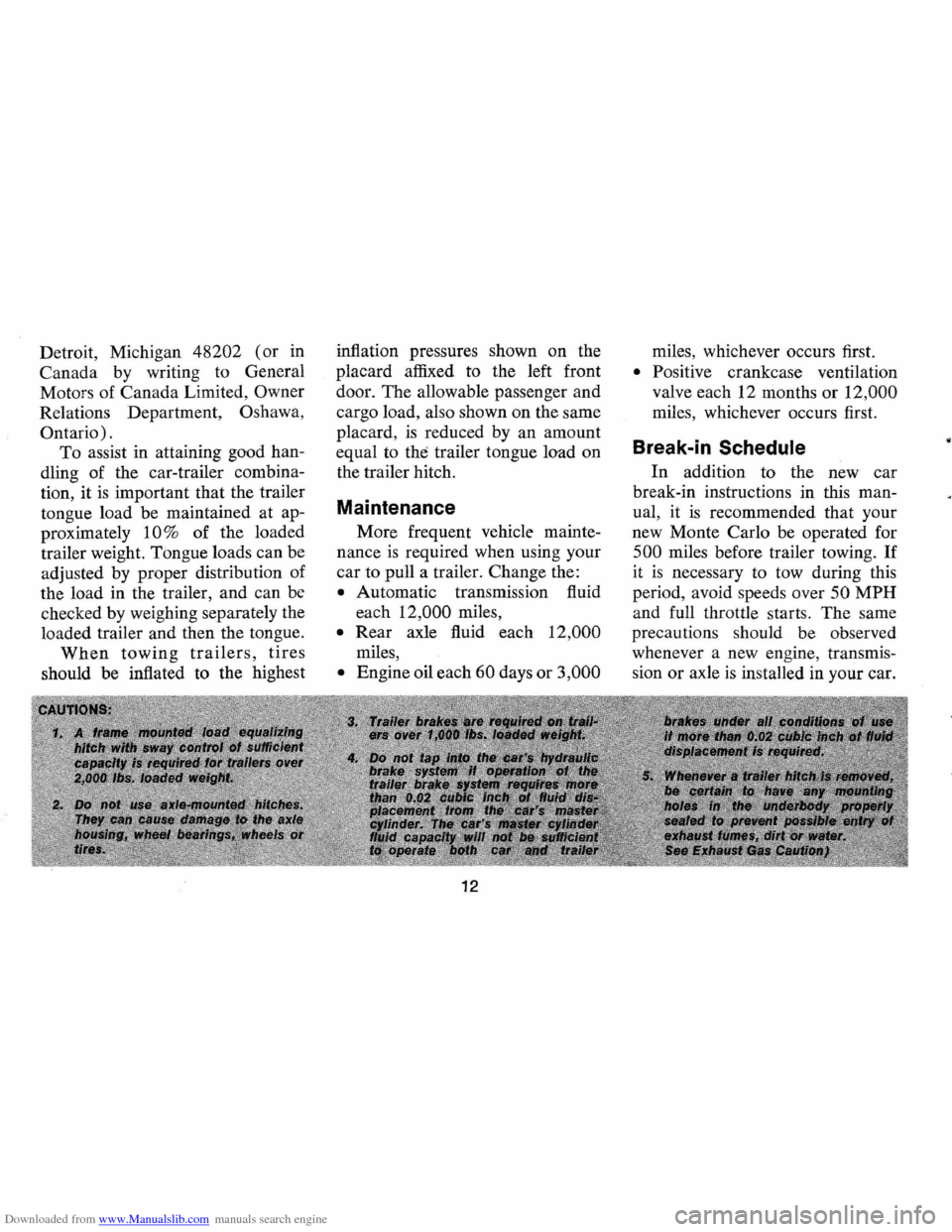
Downloaded from www.Manualslib.com manuals search engine Detroit, Michigan 48202 (or in
Canada by writing to General
Moto rs of Canada Limited,
Owner
Relations Department , Oshawa,
Ontario) .
To assist in attaining good han
dling of the car-trailer combina
tion, it
is important that the trailer
tongue load be maintained at ap
proximately
10% of the loaded
trailer weight. Tongue loads can be
adjusted by proper distribution of
the load in the trailer, and can be
checked by weighing separately the
loaded trailer and then the tongue.
When towing trailers, tires
should be inflated to the highest inflation
pressures shown on the
placard affixed to the left front
door . The allowable passenger and
cargo load, also shown on the same
placard ,
is reduced by an amount
equal to
the trailer tongue load on
the trailer hitch.
Maintenance
More frequent vehicle mainte
nance
is required when using your
car to pull a trailer. Change the:
• Automatic transmission fluid
each
12 ,000 miles ,
• Rear axle fluid each 12,000
miles,
• Engine oil each 60 days or 3,000
12
miles , whichever occurs first.
• Positive crankcase ventilation
valve each 12 months or
12,000
miles, whichever occurs first.
Break-in Schedule
In addition to the new ca r
break-in instructions in this man
ual, it
is recommended that your
new Monte Carlo be operated for
500 miles before trailer towing. If
it is necessary to tow during this
period , avoid speeds over
50 MPH
and full throttle starts. The same
precautions should be observed
whenever a new engine, transmis
sion or axle
is installed in your car.
Page 46 of 86

Downloaded from www.Manualslib.com manuals search engine Changing Tires
Preparations:
• Park on a level surface and set
parking brake firmly.
• Set automatic transmission in
"P ARK" (manual transmission
in reverse) .
• Activate hazard warning flasher.
• Block both the front and back
of the wheel diagonally oppo
site the
jack position.
Jacking Instructions
1. After removing spare wheel and
tire, jack, jack base, and jack
handle (wheel nut wrench) , pro
ceed with changing the wheel
as
follows: 2.
Remove hub cap
or wheel cover
with flat end of wheel nut wrench
and loosen, but do not remove
nuts, by turning counterclock
wise.
44
3. Place the jack column assembly
in the jack base (make sure that
jack column
is fully inserted into
jack base) and move jack lever
to the
"UP" position. Also, check
Page 47 of 86
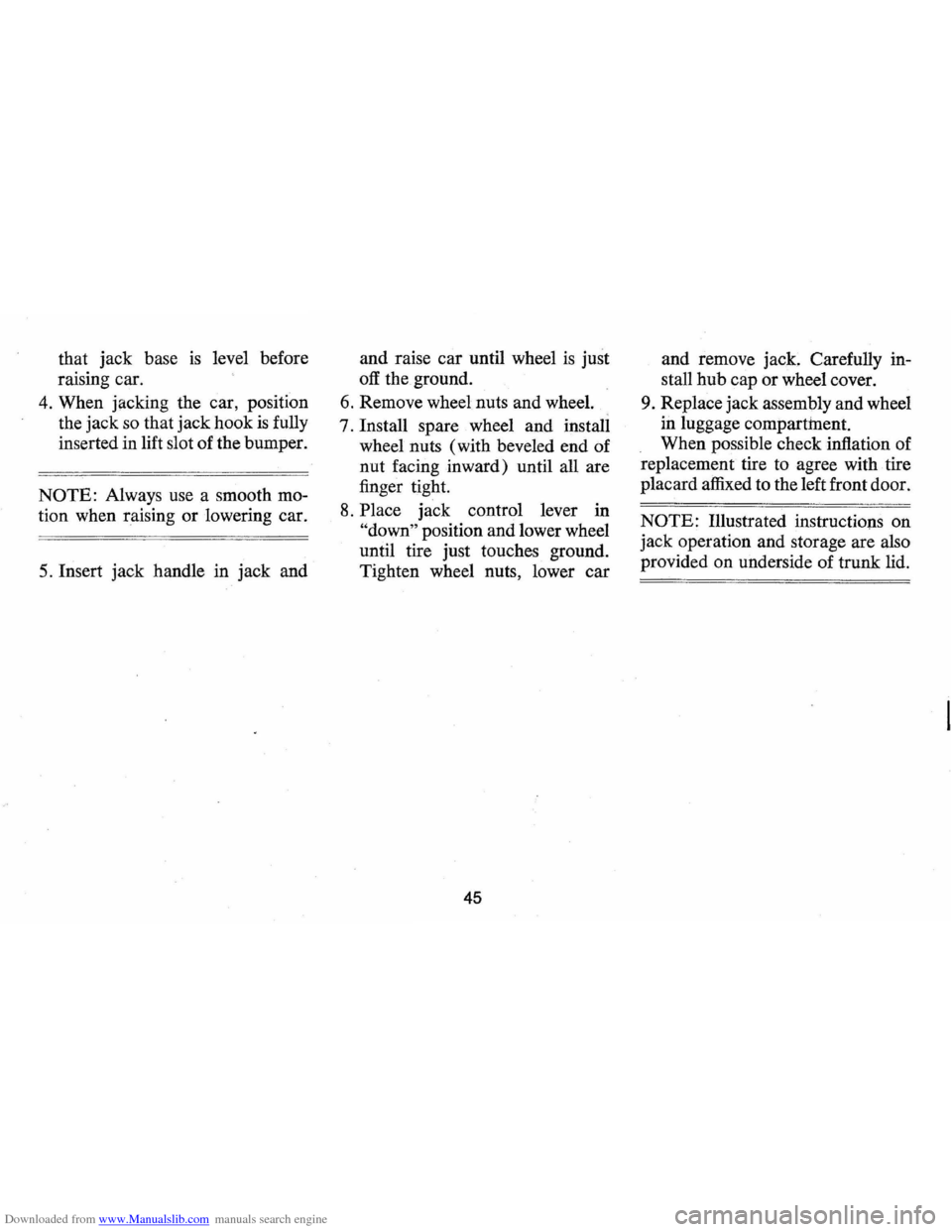
Downloaded from www.Manualslib.com manuals search engine that jack base is level before
raising car.
4. When jacking the car, position
the jack
so that jack hook is fully
inserted in lift slot of the bumper.
NOTE: Always use a smooth mo
tion when raising or lowering car.
5. Insert jack handle in jack and and
raise car until wheel
is just
off the ground.
6. Remove wheel nuts and wheel.
7. Install spare wheel and install
wheel nuts (with beveled end of
nut facing inward) until all are
finger tight.
8. Place jack control lever in
"down" position and lower wheel
until tire just touches ground.
Tighten wheel nuts, lower car
45
and remove jack. Carefully in
stall hub cap or wheel cover.
9. Replace jack assembly and wheel
in luggage compartment.
When possible check inflation of
replacement tire to agree with tire
placard affixed to the left front door.
NOTE: Illustrated instructions on
jack operation and storage are also
provided on underside of trunk lid.
Page 62 of 86

Downloaded from www.Manualslib.com manuals search engine • Maintain cooling system freeze
protection at
.;...200 F or below
to ensure protection against
corrosion and loss of coolant
from boiling , even though freez
ing temperatures are not
ex
pected.
• Add ethylene glycol base cool
ant that meets GM Specification
1899-M when coolant additions
are required because of coolant
loss or to provide additional
protection against freezing at
temperatures lower than
_200 F
(_320 F in Canada).
NOTE: Alcohol or methanol base
coolants or plain water are not
recommended for your Monte
Carlo at any time.
Radiator Pressure Cap
The radiator cap, a 15 lb. pres
sure type, must be installed tightly,
otherwise coolant may be lost and
damage to engine may result from
overheating. Radiator pressure caps
should be checked periodically for
proper operation.
If replacement is
required specify AC.
Thermostat
The cooling system is protected
and controlled by a thermostat in
stalled in the engine coolant outlet
to maintain a satisfactory operating
temperature of the engine. This
thermostat
is designed for continu
ous use through both winter and
summer and need not be changed
seasonally . When replacement
is
necessary, Delco parts are recom
mended.
60
Tires
The factory installed tires on
your car
as shown on the following
Tire Usage chart are designed to
provide the best all around per
formance for normal vehicle op
eration. When inflated
as recom
mended on the tire pressure plac
ard, located on the left door of
your vehicle, they have the load
carrying capacity to operate satis
factorily at all normal highway
speeds.
Tire Care
Tires should be checked regu
larly for proper inflation pressure,
wear, and damage. The following
information will assist you in prop
erly caring for your tires:
Page 63 of 86
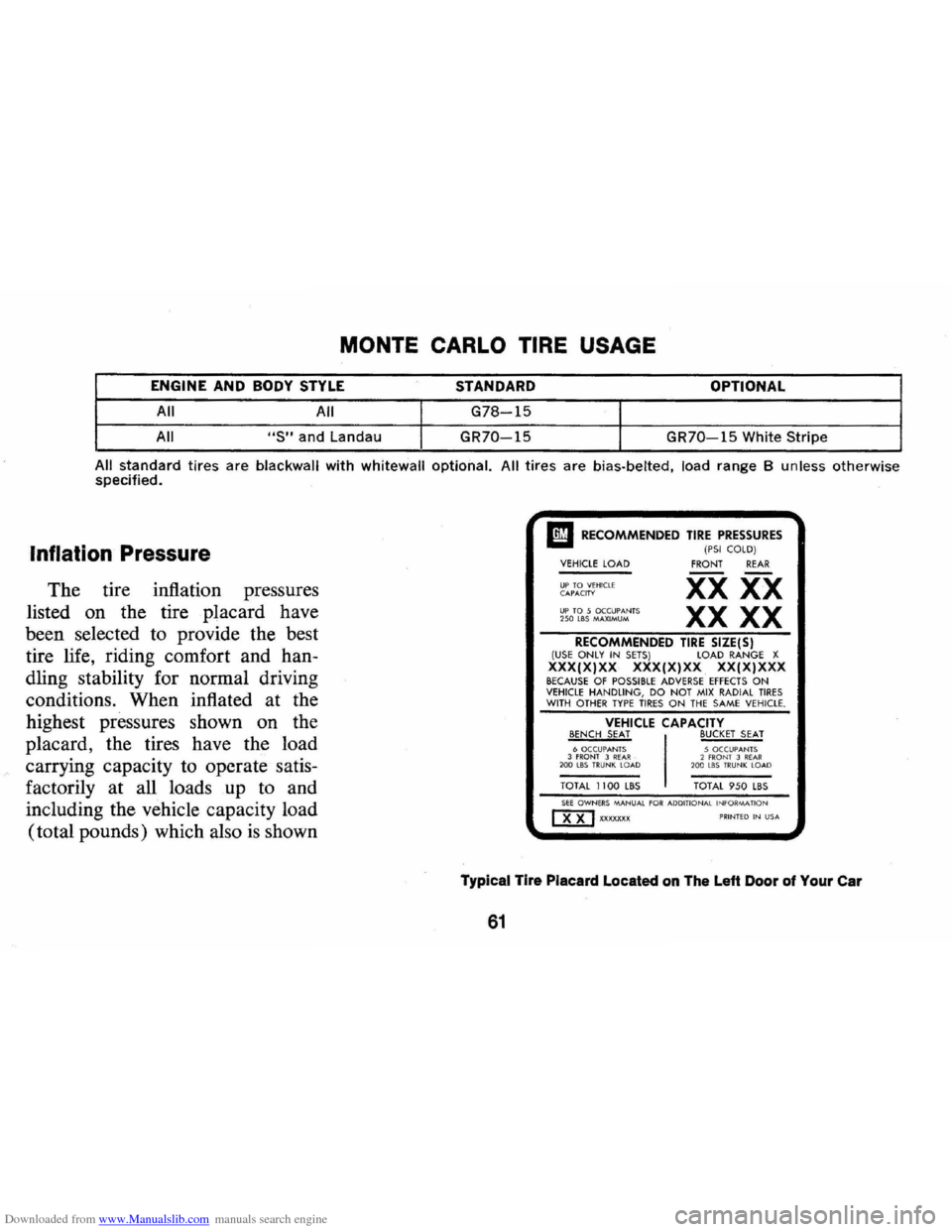
Downloaded from www.Manualslib.com manuals search engine MONTE CARLO TIRE USAGE
ENGINE AND BODY STYLE STANDARD OPTIONAL
All All
G78-15
All "S" and Landau GR70-15
GR70-15 White Stripe
All standard tires are blackwall with whitewall optional. All tires are bias·belted, load range B unless otherwise specified.
Inflation Pressure
The tire inflation pressures
listed on the tire placard have
been selected to provide the best
tire life, riding comfort and han
dling stability for normal driving
conditions. When inflated at the
highest pressures shown on the
placard, the tires have the load
carrying capacity to operate satis
factorily at all loads up to and
including the vehicle capacity load
(total pounds) which also
is shown
I!I RECOMMENDED TIRE PRESSURES (PSI COLD) VEHICLE LOAD
UP TO VEHICLE C APACIH UP TO 5 OCCU PANTS 250 185 MAX IMUM
FRONT REAR
xx XX
XX XX
RECOMMENDED TIRE SIZE(S) (USE ON LY IN SETS ) LOAD RANGE X XXX(X)XX XXX(X)XX XXIX)XXX BECAUSE OF POSSIBLE ADVERSE EFFECTS ON VEHICLE HANDLING, DO N O T MIX RADIAL TIRES WITH OTHER TYPE TIRES ON THE SA ME VEHICLE.
VEHICLE CAPACITY BENCH SEAT BUCKET SEAT 6 OCCUPANTS 3 fR ONT 3 REAR· 200 lBS TRUNK LOAD
TOTAL 1100 LBS
5 OCCUPAN TS 2 fR ONT 3 R EA R 200 U1S TRU NK LOA D
TOTAL 950 LBS SEE OWNERS MANUAL fOR ADD ITIONAL INfORMAflON mJ XXXXXXX PRINTED IN USA
Typical Tire Placard Located on The Left Door of Your Car
61
Page 64 of 86
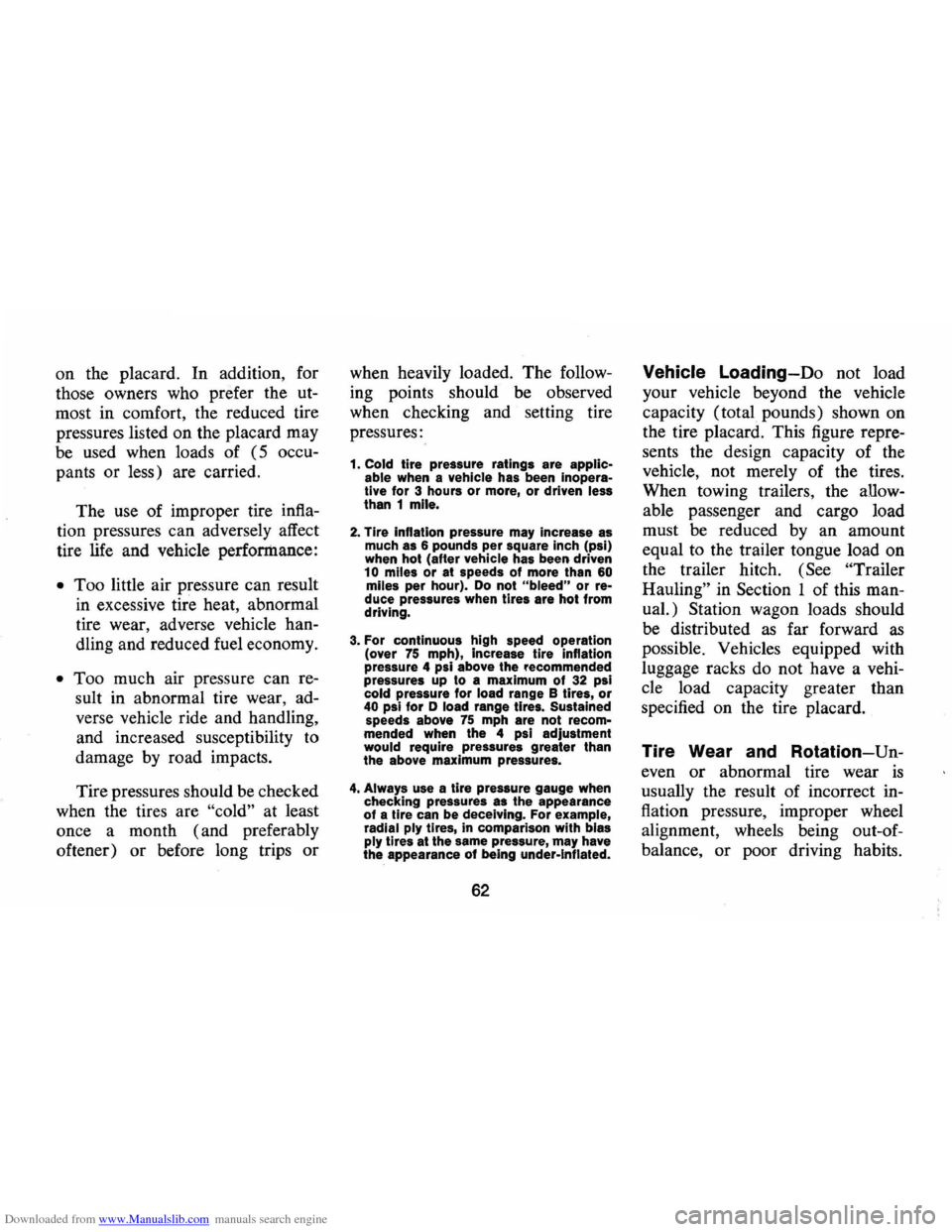
Downloaded from www.Manualslib.com manuals search engine on the placard. In addition, for
those owners who prefer the
ut
most in comfort, the reduced tire
pressures listed on the placard may
be used when loads of
(5 occu
pants or less) are carried.
The use of improper tire
infla
tion pressures can adversely affect
tire life and vehicle
perforrilance:
•
Too little air pressure can result
in excessive tire heat, abnormal
tire wear, adverse vehicle
han
dling and reduced fuel economy.
• Too much air pressure can re
sult in abnormal tire wear, ad
verse vehicle ride and handling,
and increased susceptibility to
damage
by road impacts.
Tire pressures should be checked
when the tires are
"cold" at least
once a month (and preferably
oftener)
or before long trips or
when heavily loaded. The follow
ing points should be observed
when checking and setting tire
pressures:
<
1. Cold tire pressure ratings are applic
able when a vehicle has been Inoperative for 3 hours or more, or driven less
than 1 mile.
2. Tire inflation pressure may increase as much as 6 pounds per square inch (psi)
when hot (after vehicle has been driven
10 miles or at speeds of more than 60 miles per hour). Do not "bleed" or reduce pressures when tires are hot from
driving.
3. For continuous high speed operation
(over 75 mph), increase tire inflation
pressure 4 psi above the fecommended
pressures up to a maximum
of 32 psi
cold pressure for load range B tires, or 40 psi for D load range tires. Sustained
speeds above 75 mph are not recom
mended when the 4 psi adjustment
would require pressures greater than
the above maximum pressures.
4. Always use a tire pressure gauge when
checking pressures as the appearance of a tire can be deceiving. For example,
radial ply tires, in comparison with bias
ply tires at the same pressure, may have
the appearance of being under-Inflated.
62
Vehicle Loading-Do not load
your vehicle beyond the vehicle
capacity (total pounds) shown on
the tire placard. This figure
repre
sents the design capacity of the
vehicle, not merely of the tires.
When towing trailers, the
allow
able passenger and cargo load
must be reduced by an amount
equal to the trailer tongue load on
the trailer hitch.
(See "Trailer
Hauling" in Section 1 of this man
ual.) Station wagon loads should
be distributed
as far forward as
possible. Vehicles equipped with
luggage racks do not have a
vehi
cle load capacity greater than
specified on the tire placard.
Tire Wear and Rotation-Un
even or abnormal tire wear is
usually the result of incorrect in
flation pressure, improper wheel
alignment, wheels being
out-of
balance, or poor driving habits.
Page 65 of 86
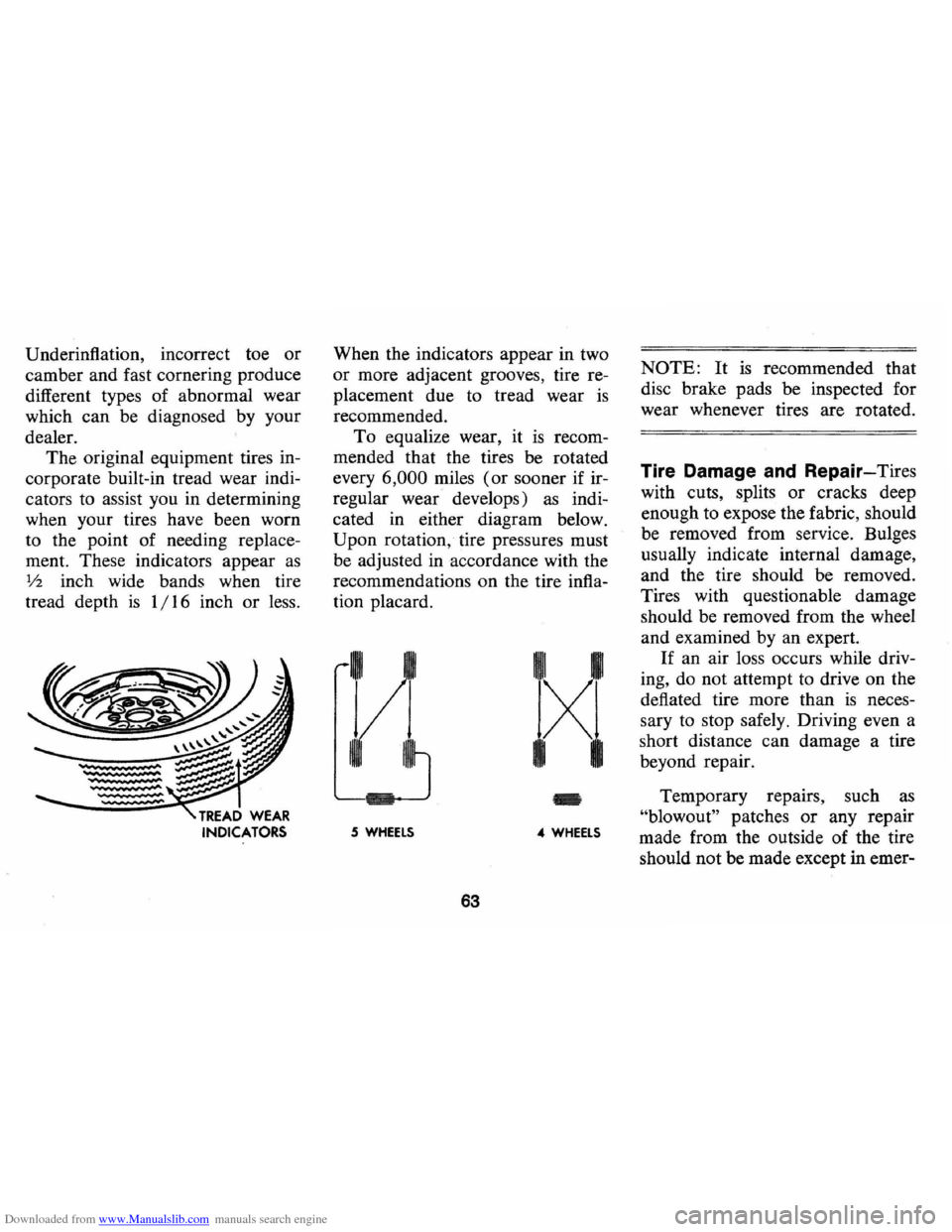
Downloaded from www.Manualslib.com manuals search engine Underinftation, incorrect toe or
camber and fast cornering produce
different types of abnormal wear
which
can be diagnosed by your
dealer.
The original equipment tires in
corporate built-in tread wear indi
cators to assist you in determining
when your tires have been worn
to the point of needing replace
ment. These indicators appear
as
V2 inch wide bands when tire
tread depth
is 1/16 inch or less. When
the indicators appear in two
or more adjacent grooves, tire re
placement due to tread wear
is
recommended.
To equalize wear, it is recom
mended that the tires be rotated
every
6,000 miles (or sooner if ir
regular wear develops)
as indi
cated in either diagram below.
Upon rotation, tire pressures must
be adjusted in accordance with the
recommendations
on the tire infla
tion placard.
II I
Vi
..
5 WHEELS 4 WHEELS
63
NOTE: It is recommended that
disc brake pads be inspected for
wear whenever tires are rotated.
Tire Damage and Repair-Tires
with cuts, splits or cracks deep
enough to expose the fabric, should
be removed from service. Bulges
usually indicate internal damage,
and the tire should be removed.
Tires with questionable damage
should be removed from the wheel
and examined by an expert.
If an air loss occurs while driv
ing, do not attempt to drive on the
deflated tire more than
is neces
sary to stop safely. Driving even a
short distance
can damage a tire
beyond repair.
Temporary repairs, such as
"blowout" patches or any repair
made from the outside of the tire
should not be made except in emer-